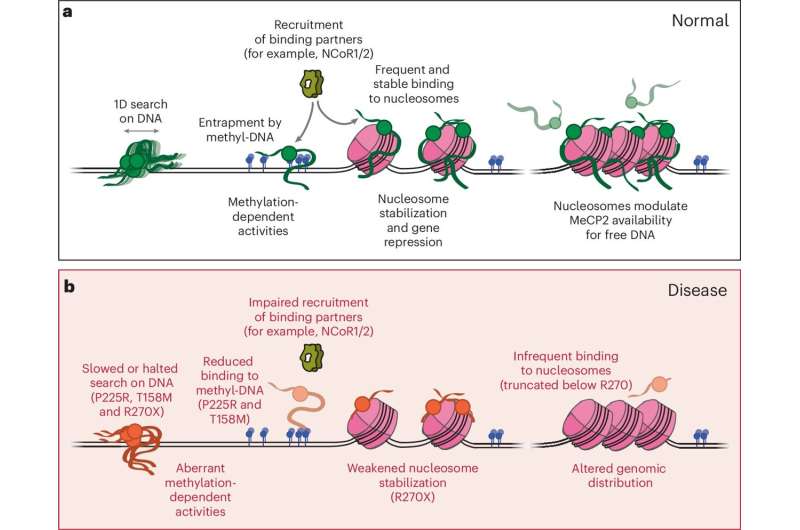This article has been reviewed according to Science X's editorial process and policies. Editors have highlighted the following attributes while ensuring the content's credibility:
fact-checked
peer-reviewed publication
trusted source
proofread
New insight into the protein mutations that cause Rett syndrome

One particular protein lies at the heart of brain development. A master regulator of gene expression, it's abundantly present in neurons, and its dysfunction underlies Rett syndrome, a neurological disorder that could lead to severe cognitive, motor, and communication impairments in young girls.
Yet scientists understand little about how this essential protein does its crucial work at the molecular level. "People have been studying this protein for decades without a clear consensus on what it is doing, where it binds to the genome, and what its functions are," says Rockefeller's Shixin Liu. Now, a new study from Liu's laboratory sheds light on how the protein, MeCP2, interacts with DNA and chromatin.
The findings, published in Nature Structural & Molecular Biology, provide insight into this master regulator, and could open up new avenues for Rett syndrome therapies.
A single-molecule approach
MeCP2 is a baffling protein. While it has been implicated in the regulation of thousands of genes and is thought to be central to neurodevelopment, its impacts on the genome are tricky to pin down. Insufficient amounts of wildtype MeCP2 causes Rett syndrome, but too much of the protein causes a similarly debilitating neurological disorder known as MeCP2 duplication syndrome.
Liu and colleagues leveraged the lab's area of expertise—single-molecule observation and manipulation—to better understand how MeCP2 interacts with DNA. The team tethered a single piece of DNA between micron-sized plastic beads, each held by a laser, and then incubated the DNA with fluorescently labeled MeCP2 proteins. This setup allowed them to closely monitor the mysterious protein's dynamic behavior.
MeCP2 is generally thought to exclusively perform its functions on DNA that is modified with methylated cytosines, but lacked a satisfactory explanation for such specificity, since the protein readily binds both methylated and unmethylated DNA.
The team found that MeCP2 dynamically moves on DNA, but in a much slower manner in regards to the methylated form compared to the unmethylated one. They further showed that these different dynamics allow MeCP2 to recruit another regulatory protein more efficiently to methylated DNA sites, which may help direct MeCP2's gene regulatory functions towards specific locations within the genome.
"We found that MeCP2 slides along unmethylated DNA faster, and this difference in motion may explain how the protein differentiates between the two," says Gabriella Chua, a graduate fellow in Liu's lab and first author on the paper.
"That's something we could only have discovered using a single-molecule technique."
Liu and Chua also found that the protein shows a very strong preference for binding to nucleosomes, protein spools that are wound with our genetic material, over bare DNA. This interaction stabilizes nucleosomes in a way that may suppress gene transcription—hinting at how MeCP2 itself regulates gene expression.
New thinking about nucleosomes
The observation that a master regulator of gene expression most often interacts with this tightly wound form of DNA helps bolster a growing notion that nucleosomes are far more than inert "storage spools" of DNA, and that scientists need to begin thinking of MeCP2's function more in the context of nucleosomes.
"Our data is one of the most definitive examples of this phenomenon to date," Liu says. "It's clear that MeCP2 prefers binding to nucleosomes."
In this way, MeCP2 functions as a chromatin-binding protein, contrasting the conventional view that sees it chiefly as a methyl-DNA-binding protein. In this study, the team has also narrowed in on the part of the protein that is responsible for its nucleosome-binding activity.
"Bare DNA is in the minority—nucleosomes are pervasive in our genomes," Chua says. "Several recent studies have demonstrated that nucleosomes are not merely passive barriers to transcription, but active hotspots for gene regulation."
A particularly striking example of such nucleosome functionality is how MeCP2 interacts with it.
In future work, the team plans to expand beyond the present in vitro study to examine MeCP2 in vivo, where interactions between the protein and the nucleosome are expected to be more complex. They also intend to use the techniques described in this paper to better study the many MeCP2 mutations that cause diseases such as Rett syndrome.
The hope is that a more complete understanding of the protein central to this devastating disease may one day lead to therapies.
"There's no cure for Rett, but the community of researchers studying it are determined and energized. Many found our data intriguing when we shared it with them," Chua says. "Our findings highlight how basic research can help the clinical community better understand a disease."
More information: Gabriella N. L. Chua et al, Differential dynamics specify MeCP2 function at nucleosomes and methylated DNA, Nature Structural & Molecular Biology (2024). DOI: 10.1038/s41594-024-01373-9


















